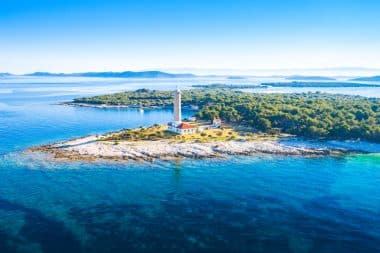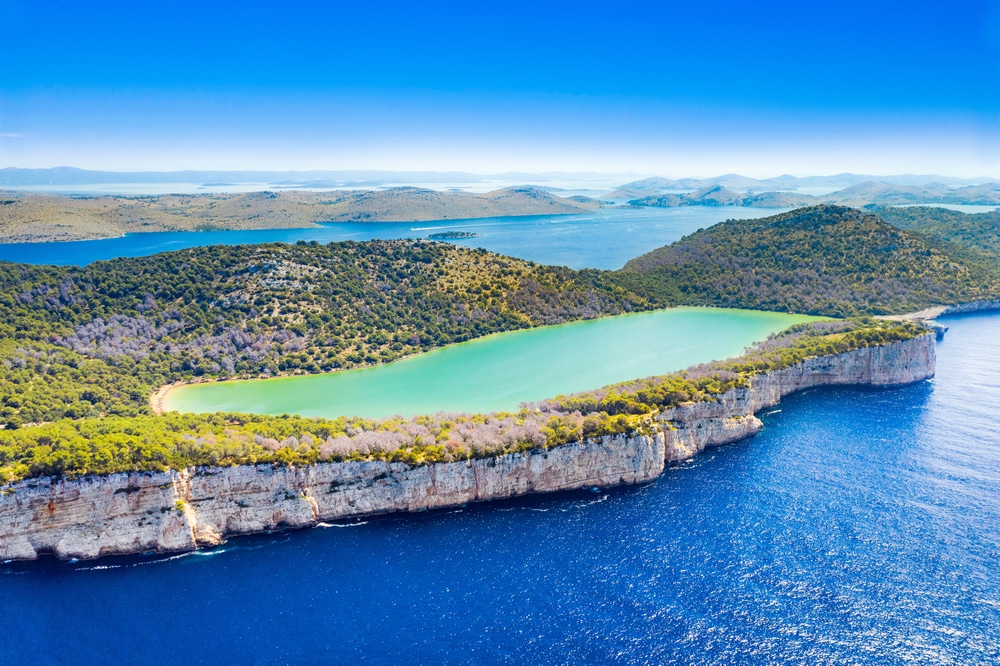Remains of human bones from the early Middle Stone Age found in a cave during excavations in 2011 prove that Dugi Otok, the largest of the Zadar islands off the Dalmatian coast with an area of 114 km², was probably permanently settled about 11,000 years ago. The island, which is just over 44 kilometres long and almost 5 kilometres wide, only a few kilometres west of and off the Croatian port city of Zadar, bears its name due to its characteristic shape.
Most of the island’s current 2,900 inhabitants live in the largest cities and towns on the east coast, which faces the mainland. The steep, strongly rugged west coast, on the other hand, which faces the open sea, is much more sparsely populated. Dugi Otok is popular as a hospitable holiday destination mainly because of its almost completely untouched maritime nature with beautiful landscapes. Particularly well-known and well visited in summer is the 70 km² Telašćica Nature Park in the south-eastern part, with 25 small beaches and the therapeutically used salt lake of Mir stretching across its bay.
Not only dolphins, falcons and donkeys feel “right at home” in the nature of the island

The landscape of the nature park is also characterized by cliffs up to over 160 meters high, from which you have fantastic views over the sea and the Croatian mainland as well as the neighboring archipelago of the Kornati Islands to the south. Falcons nest on and in the cliffs, the waters in front of the rocks are populated by crabs, corals, sea urchins and sponges. With a bit of luck, visitors will also see dolphins swimming directly off the coast, and there is also a small donkey sanctuary in the park: donkeys used to be an important part of daily life on Dugi Otok. The bay of Telašćica is often praised as the most beautiful of its kind on the Adriatic, the truly spectacular cliffs, the azure blue water and the sometimes tiny islands result in a unique panorama that is perfect for a leisurely picnic in a shady spot. Connected to the sea by several underground canals, Lake Mir is another natural monument. This saltwater lake is warmer than the sea in summer and colder in winter, the water temperature can fluctuate between 33 and 5 degrees Celsius throughout the year.
The almost deserted west coast is a perfect refuge for those seeking peace and quiet
Two of the most beautiful and well-known sandy beaches on Dugi Otok are undoubtedly the rather secluded Saharun beach in the northwest of the island, whose golden sand contrasts with turquoise waters, and the at least equally picturesque Veli Žal beach near Dragove a little further south. The Saharun beach, which is quite quiet even in the summer high season, near the northern tip of the island near the two villages of Božava and Veli Rat, is still an insider tip and is therefore particularly suitable for families with children. The dark green pine forests around the bay provide shade and shelter from the hot sun, the beach slopes gently towards the sea.
From June to September, two beach bars open, which also rent out loungers and parasols, and sailboats are often anchored beyond the cordoned-off bathing area. During this time, a narrow-gauge railway runs on the approx. 4 km long line from Božava to Saharun. Otherwise, there is no development, the nearest parking lot is discreetly hidden behind a pine forest. The sand and pebble beach of Veli Žal is located opposite the island of Mežanj and is similarly quiet and almost never crowded. Here the water gets deeper a little faster, food and drinks are also available seasonally at a small beach bar.
The sea around Dugi Otok is also a sought-after sailing and diving area

Not far from these two beaches is also the bay Brbinjšćica southwest of the town of Brbinj in the northeast, which is considered one of the safest anchorages and best places for diving on Dugi Otok. The beach of Veli Rat in the Čuna Bay in the north attracts many guests and visitors, the two small pebble beaches that are ideal for children and are surrounded by large and shady pine trees. There is also a beach bar and sanitary facilities and campsites nearby. The Veli Rat lighthouse from 1849 is often chosen as an excursion destination and photo motif, which is the highest lighthouse on the Croatian coast at 42 meters and can be climbed over 200 spiral steps. The same applies to the mysterious stalactite cave Strasna Pec between the villages of Savar and Luka, where you can cool off from the heat above ground during guided tours. On the southern tip of the Mir salt lake, on the other hand, Lojišće beach is devoid of any gastronomy and tourist infrastructure, but with fantastic places to sleep under the sparkling starry sky.
Whether on foot, by car or by bike: there is a lot to discover on the island
The authentic villages and communities on the island are ideal for small excursions and day trips on foot, by bike or rental car. Sali is currently the largest settlement on the island with about 750 inhabitants and the gateway to the Telašćica Nature Park, where the ferries from Zadar dock. Luka is located on Vela Straža, the highest peak on Dugi Otoki and Boka Bay, and is known for its healing mud. Savar has a picturesque church at the end of a small peninsula, and there are many quarries in the area. Brbinj, between the bays of Jaz and Lučina, is surrounded by dense olive groves. Božava with its pine forests is a popular tourist destination with numerous accommodations. Not far from the village are the former submarine bunkers of the former Yugoslav People’s Army, which were built into the rocks. Pantera Bay near Verunić is popular among divers because of a shipwreck.


